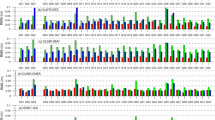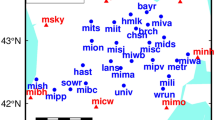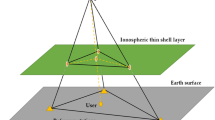Abstract
Ionospheric corrections are critical in fast precise point positioning real-time kinematic (PPP-RTK), in which the regional slant ionospheric model (RSIM) is commonly used. For the conventional RSIM, only common satellites tracked by the whole set of reference stations are selected in delivering the network corrections to keep the receiver-related biases consistent. This decreases the number of available satellites. Therefore, two kinds of aligned RSIMs are proposed by recovering ionospheric observables and aligning ionospheric observables with the same pivot receiver-related bias. The proposed methods derive a consistent ionospheric model with more satellites involved. Effective strategies to transfer receiver-related biases are investigated, where satellites with a high elevation and many ambiguity-fixed epochs show better performance. To validate the performance of the proposed method, both static and kinematic positioning tests are carried out. For the static test, the aligned RSIM achieved faster convergence than the conventional RSIM, and the positioning accuracy in the east, north, and vertical after the first 1 min is 0.029, 0.026, and 0.074 m, respectively. For the kinematic test, the root mean square (RMS) of positioning errors reduces from 1.00 to 0.65 m for the east, from 0.54 to 0.43 m for the north, and from 0.89 to 0.71 m for the vertical component using the aligned model. Also, two typical urban experiments were carried out, demonstrating a fast convergence within 16 s when the aligned RSIM is added.













Similar content being viewed by others
Data availability
Data are available from the corresponding author on reasonable request.
Abbreviations
- CAS:
-
Chinese academy of sciences
- DCBs:
-
Differential code biases
- GBM:
-
GeoBM
- GIM:
-
Global ionospheric map
- IGS:
-
International GNSS Service
- IMU:
-
Inertial measurement unit
- NAUG:
-
Number of satellites with ionospheric augmentation information
- NSAT:
-
Number of satellites
- PPP:
-
Precise point positioning
- PPP-RTK:
-
Precise point positioning real-time kinematic
- PPP-RTK(A):
-
PPP-RTK constrained with the aligned RSIM-1
- PPP-RTK(C):
-
PPP-RTK constrained with the conventional RSIM
- QZSS:
-
Quasi-Zenith satellite system
- RSIM:
-
Regional slant ionospheric model
- STD:
-
Standard deviation
- STEC:
-
Slant total electron content
- TECU:
-
Total electr
- UPD:
-
Uncalibrated phase delay
- VTEC:
-
Vertical total electron content
References
Bisnath S, Gao Y (2009) Current state of precise point positioning and future prospects and limitations. In observing our changing earth. Springer
Ciraolo L, Azpilicueta F, Brunini C, Meza A, Radicella SM (2006) Calibration errors on experimental slant total electron content (TEC) determined with GPS. J Geodesy 81(2):111–120. https://doi.org/10.1007/s00190-006-0093-1
Ge M, Douša J, Li X, Ramatschi M, Nischan T, Wickert J (2012) A novel real-time precise positioning service system: global precise point positioning with regional augmentation. J Global Position Syst 11(1):2–10. https://doi.org/10.5081/jgps.11.1.2
Geng J, Teferle FN, Meng X, Dodson AH (2011) Towards PPP-RTK: ambiguity resolution in real-time precise point positioning. Adv Space Res 47(10):1664–1673. https://doi.org/10.1016/j.asr.2010.03.030
Gu S, Dai C, Fang W, Zheng F, Wang Y, Zhang Q, Niu X (2021) Multi-GNSS PPP/INS tightly coupled integration with atmospheric augmentation and its application in urban vehicle navigation. J Geodesy. https://doi.org/10.1007/s00190-021-01514-8
Li P, Zhang X (2013) Integrating GPS and GLONASS to accelerate convergence and initialization times of precise point positioning. GPS Solutions 18(3):461–471. https://doi.org/10.1007/s10291-013-0345-5
Li W, Li Z, Wang N, Liu A, Zhou K, Yuan H, Krankowski A (2021) A satellite-based method for modeling ionospheric slant TEC from GNSS observations: algorithm and validation. GPS Solut. https://doi.org/10.1007/s10291-021-01191-2
Li X, Huang J, Li X, Lyu H, Wang B, Xiong Y, Xie W (2021) Multi-constellation GNSS PPP instantaneous ambiguity resolution with precise atmospheric corrections augmentation. GPS Solut 25:3. https://doi.org/10.1007/s10291-021-01123-0
Li X, Zhang X, Ge M (2010) Regional reference network augmented precise point positioning for instantaneous ambiguity resolution. J Geodesy 85(3):151–158. https://doi.org/10.1007/s00190-010-0424-0
Liu T, Zhang B, Yuan Y, Li Z, Wang N (2019) Multi-GNSS triple-frequency differential code bias (DCB) determination with precise point positioning (PPP). J Geodesy 93(5):765–784. https://doi.org/10.1007/s00190-018-1194-3
Malys S, Jensen P (1990) Geodetic point positioning with GPS carrier beat phase data from the CASA UNO experiment. Geophys Res Lett 17(5):651–654
Miya M, Fujita S, Sato Y, Ota K, Hirokawa R, Takiguchi J. Centimeter level augmentation service (CLAS) in Japanese Quasi-Zenith satellite system, its user interface, detailed design, and plan. Proc. ION GNSS 2016, Institute of Navigation, Tampa, Florida, USA, September 14–18, 2864–2869.
Odijk D, Teunissen P J G, Khodabandeh A. (2014). Single-frequency PPP-RTK: theory and experimental results. In Earth on the Edge: Science for a Sustainable Planet (pp. 571–578).
Orús R, Hernández-Pajares M, Juan J, Sanz J (2005) Improvement of global ionospheric VTEC maps by using Kriging interpolation technique. J Atmos Solar Terr Phys 67(16):1598–1609. https://doi.org/10.1016/j.jastp.2005.07.017
Psychas D, Verhagen S (2020) Real-time PPP-RTK performance analysis using ionospheric corrections from multi-scale network configurations. Sensors 20:11. https://doi.org/10.3390/s20113012
Psychas D, Verhagen S, Liu X, Memarzadeh Y, Visser H (2019) Assessment of ionospheric corrections for PPP-RTK using regional ionosphere modelling. Measure Sci Technol 30:1. https://doi.org/10.1088/1361-6501/aaefe5
Ren X, Chen J, Li X, Zhang X (2021) Ionospheric total electron content estimation using GNSS carrier phase observations based on zero-difference integer ambiguity: methodology and assessment. IEEE Trans Geosci Remote Sens 59(1):817–830. https://doi.org/10.1109/tgrs.2020.2989131
Rovira-Garcia A, Juan JM, Sanz J, Gonzalez-Casado G (2015) A worldwide ionospheric model for fast precise point positioning. IEEE Trans Geosci Remote Sens 53(8):4596–4604. https://doi.org/10.1109/tgrs.2015.2402598
Schaer S (1999) Mapping and predicting the earth's ionosphere using the global positioning system (Vol. 59): Institut für Geodäsie und Photogrammetrie, Eidg. Technische Hochschule.
Teunissen P, Odijk D, Zhang B (2010) PPP-RTK: results of CORS network-based PPP with integer ambiguity resolution. J Aeronaut, Astronaut Aviat 42(4):223–230
Wang H, Sui Y, Wang D, Fu H, Feng S. Un-difference PPP method and performance assessment based on regional ionospheric model. Proc. China Satellite Navigation Conference (CSNC) 2020, Springer, Cheng Du, China, 684–695.
Wübbena G, Schmitz M, Bagge A. PPP-RTK: Precise point positioning using state-space representation in RTK networks. Proc. ION GNSS 2005, Institute of Navigation, Long Beach, California, USA, 2584–2594.
Xiang Y, Gao Y (2017) Improving DCB estimation using uncombined PPP. Navigation 64(4):463–473. https://doi.org/10.1002/navi.207
Xiang Y, Gao Y, Li Y. Ionospheric STEC and VTEC constraints for fast PPP. Proceeding China Satellite Navigation Conference (CSNC) 2017 Proceedings: Volume II 2017 257–269.
Zha J, Zhang B, Liu T, Hou P (2021) Ionosphere-weighted undifferenced and uncombined PPP-RTK: theoretical models and experimental results. GPS Solut 25(4):1–12. https://doi.org/10.1007/s10291-021-01169-0
Zhang B, Chen Y, Yuan Y (2018) PPP-RTK based on undifferenced and uncombined observations theoretical and practical aspects. J Geodesy 93(7):1011–1024. https://doi.org/10.1007/s00190-018-1220-5
Zhang B, Teunissen PJG, Odijk D (2011) A novel un-differenced PPP-RTK concept. J Navig 64(S1):S180–S191. https://doi.org/10.1017/s0373463311000361
Zhang X, Ren X, Chen J, Zuo X, Mei D, Liu W (2022) Investigating GNSS PPP–RTK with external ionospheric constraints. Satell Navig 3(1):1–13. https://doi.org/10.1186/s43020-022-00067-1
Zhou P, Wang J, Nie Z, Gao Y (2019) Estimation and representation of regional atmospheric corrections for augmenting real-time single-frequency PPP. GPS Solut 24(1):1–12. https://doi.org/10.1007/s10291-019-0920-5
Zumberge JF, Heflin MB, Jefferson DC, Watkins MM, Webb FH (1997) Precise point positioning for the efficient and robust analysis of GPS data from large networks. J Geophys Res: Solid Earth 102(B3):5005–5017. https://doi.org/10.1029/96jb03860
Acknowledgements
We appreciate the Geespace Company collecting the static data, which made the experiment possible. Special thanks to Yang Gao and Liang Zhao for the discussion and proofreading. The computations in this paper were run on the Siyuan cluster supported by the Center for High Performance Computing at Shanghai Jiao Tong University. We also thank the support from the National Key R&D Program of China (No. 2022YFB3904402) and Shanghai Science and Technology Committee under Grant (20511103103).
Author information
Authors and Affiliations
Corresponding author
Additional information
Publisher's Note
Springer Nature remains neutral with regard to jurisdictional claims in published maps and institutional affiliations.
Rights and permissions
Springer Nature or its licensor (e.g. a society or other partner) holds exclusive rights to this article under a publishing agreement with the author(s) or other rightsholder(s); author self-archiving of the accepted manuscript version of this article is solely governed by the terms of such publishing agreement and applicable law.
About this article
Cite this article
Lyu, S., Xiang, Y., Zhang, Y. et al. A consistent and grid-based regional slant ionospheric model with an increasing number of satellite corrections for PPP-RTK. GPS Solut 27, 97 (2023). https://doi.org/10.1007/s10291-023-01439-z
Received:
Accepted:
Published:
DOI: https://doi.org/10.1007/s10291-023-01439-z




